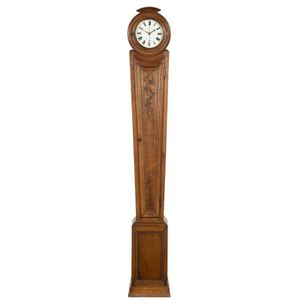George III Mahogany Trunk Dial Clock by John Wood
You must be a subscriber, and be logged in to view price and dealer details.
Subscribe Now to view actual auction price for this item
When you subscribe, you have the option of setting the currency in which to display prices to $Au, $US, $NZ or Stg.
- Mahogany - Mahogany is a dense, close grained red-coloured timber from the West Indies and Central America. It was first imported into Europe in the the early 18th century and its use continued through the 19th century. It was popular for furniture making because of its strength, the wide boards available, the distinctive grain on some boards, termed flame mahogany and the rich warm colour of the timber when it was polished.. The "flame" was produced where a limb grew out from the trunk of the tree, and this timber was usually sliced into veneers for feature panels on doors, backs and cornices.
Some terms used to describe mahogany relate to the country from which it originally came, such as "Cuban" mahogany, "Honduras" mahogany etc. However unless the wood has been tested the names assigned are more a selling feature, rather than a true indication of the timber's origin. - Timepiece - In today's usage, the word "clock" is the name given to any instrument used for measuring time, but the word clock is derived from the Celtic word meaning "bell", and traditionally a clock without a bell or chime was known as a timepiece.
- Circa - A Latin term meaning 'about', often used in the antique trade to give an approximate date for the piece, usually considered to be five years on either side of the circa year. Thus, circa 1900 means the piece was made about 1900, probably between 1895 and 1905. The expression is sometimes abbreviated to c.1900.
- Bezel - On a clock or watch, the bezel is the metal frame into which the watch or clock glass is fitted. In clocks, the bezel may include a hinge and a flange, in effect a door to the face of the clock. In jewellery the bezel is a band of metal with a projecting lip that holds the gemstone in its setting.
- Anchor Escapement - An anchor escapement is a type of mechanical escapement used in clocks and watches. It is a refinement of the older verge escapement, which was used in early mechanical timekeeping devices. The anchor escapement is characterised by the use of an anchor-shaped pallet that rocks back and forth, alternately locking and releasing the escape wheel. This action allows the movement of the watch or clock to be regulated, producing the characteristic tick-tock sound that is associated with mechanical timekeeping devices. The anchor escapement is generally more accurate and reliable than the verge escapement, and it is still used in many modern clocks and watches today.
- Movement - The technical name for the workings of a clock or watch, and does not include the dial or case.
- George Iii - George III (1738 - 1820) was King of Great Britain and Ireland from 1760 to 1820.
This item has been included into following indexes:
Visually similar items

A Georgian mahogany round dial eight day grandfather clock. Maker: J Gilchrest of Irvine. 202 cm high, 54 cm wide, 24.5 cm deep.

A Georgian mahogany cased grandfather clock with brass presentation plaque, presented to John Brooks J P, the first member of parliament for the Altrincham division of Cheshire. 212 cm high, 48 cm wide, 22 cm deep.

An unusual French provincial carved oak longcase clock, Normandy region, late 18th century, 202 cm high. Provenance: Property of a Gentleman, New South Wales

William IV Scottish long case clock in attractive solid mahogany case with round hood surmounted by carvings and tapered trunk with bow front door, circular silver painted dial signed 'D. Duff, Paisley', with matching blued steel calendar and seconds hands
